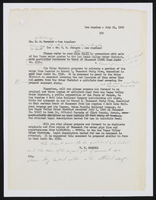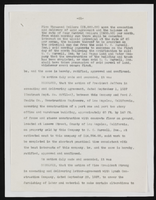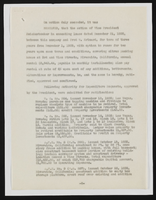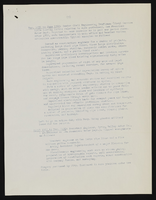Search the Special Collections and Archives Portal
Search Results

Letter from E. E. Cunningham (Yermo, Cal.) to J. P. Mack, November 27, 1930
Date
Archival Collection
Description
Discussion of selling water to people living next to the Arden Pipeline, provided they were not using the water to manufacture moonshine.
Text

Letter from F. H. Knickerbocker (Los Angeles) to Walter R. Bracken (Las Vegas), August 26, 1930
Date
Archival Collection
Description
Letter outlining the procedure for a one-time purchase of bulk drinking water on the St. Thomas line.
Text

Letter from W. R. Armstrong (Los Angeles) to E. E. Cunningham, June 19, 1930
Date
Archival Collection
Description
The sale of drinking water to the residents of the Moapa Valley were on a case by case basis.
Text

Letter from Walter R. Bracken (Las Vegas) to F. H. Knickerbocker (Los Angeles) July 25, 1928
Date
Archival Collection
Description
Walter R. Bracken of the Las Vegas Land and Water Co. approved of Knickerbocker's decision for the Union Pacific Railroad to provide Bishop Earl with water from Overton.
Text
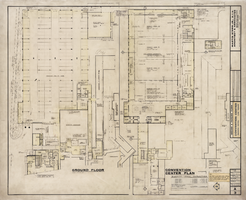
Architectural drawing of Sahara Hotel Convention Center (Las Vegas), ground and pavilion floor plan, March 22, 1967
Date
Archival Collection
Description
Architectural plans for the Sahara Hotel Convention Center from 1967. Includes revisions, notes, and banquet room capacities. Printed on mylar. Berton Charles Severson, architect; Brian Walter Webb, architect; Masyoshi Tokubo, delineator.
Site Name: Sahara Hotel and Casino
Address: 2535 Las Vegas Boulevard South
Image
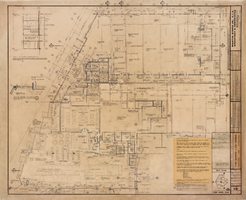
Architectural drawing of Sands Hotel (Las Vegas), additions and alterations, partial first floor plan, August 3, 1964
Date
Archival Collection
Description
Architectural plans for additions and alterations to The Sands. Includes general floor plan notes, key plan, revisions, and symbol legend. Printed on mylar. Berton Charles Severson, architect; Brian Walter Webb, architect; J. Rock, delineator.
Site Name: Sands Hotel
Address: 3355 Las Vegas Boulevard South
Image

